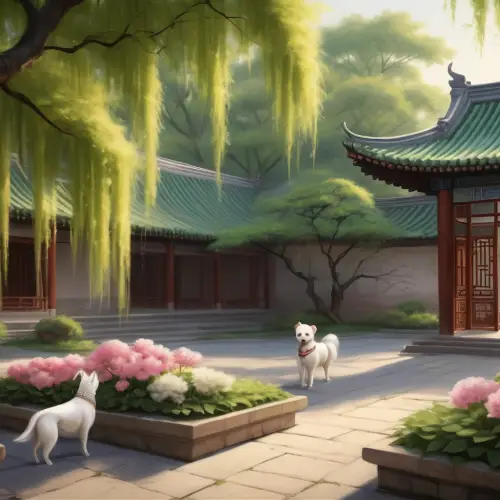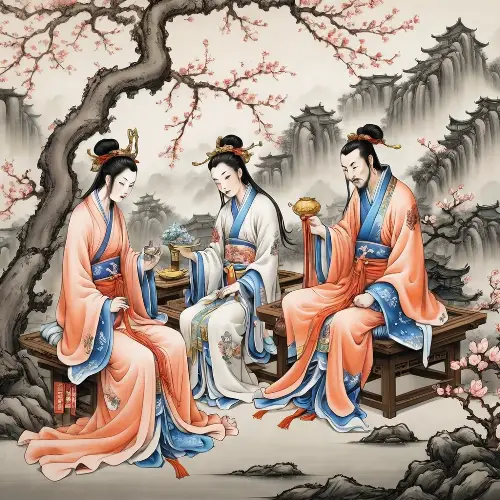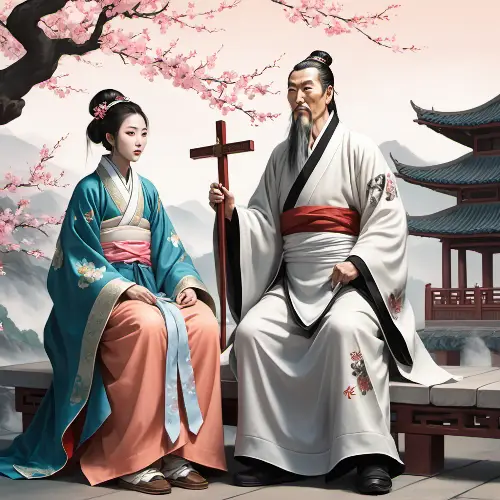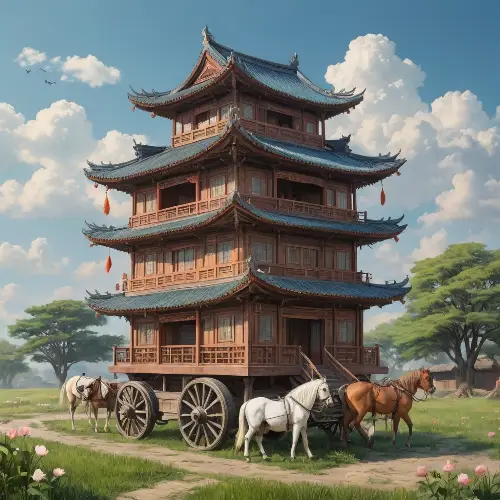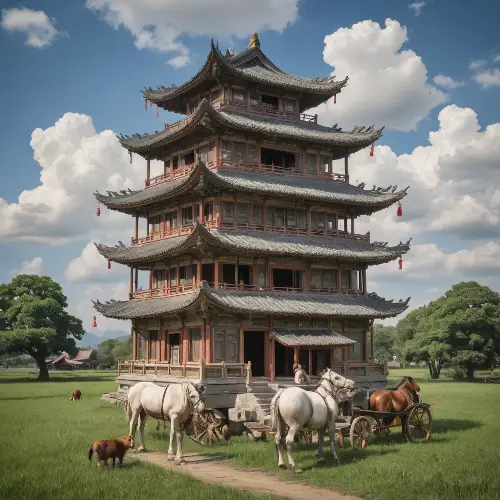\In the Qing Dynasty, the architectural landscape featured traditional courtyard houses, with a cluster of 三合院 (traditional courtyard houses) positioned in the left-center. The surroundings included farmland, where water buffaloes roamed, against a backdrop of majestic mountains and flowing rivers.\
More Like This
\In the Qing Dynasty, the architectural landscape featured traditional courtyard houses, with a cluster of 三合院 (traditional courtyard houses) positioned in the left-center. The surroundings included farmland, where water buffaloes roamed, against a backdrop of majestic mountains and flowing rivers.\
\In the Qing Dynasty, the architectural landscape featured traditional courtyard houses, with a cluster of 三合院 (traditional courtyard houses) positioned in the left-center. The surroundings included farmland, where water buffaloes roamed, against a backdrop of majestic mountains and flowing rivers.\
The scene during the Qing Dynasty depicted a picturesque landscape with vast fields, traditional architecture, and the harmonious presence of farmland. The architectural elements showcased the distinctive style of that era, surrounded by expansive agricultural fields, creating a serene and timeless atmosphere.\
\In the Qing Dynasty, Taiwanese architecture was characterized by traditional structures set against the backdrop of fertile fields, with water buffaloes grazing peacefully and majestic mountains and rivers completing the scenic landscape.\
In a forward-facing continuous horizontal sequence, from left to right, focus on Taipeis Xinyi District in Taiwan, showcasing the changing landscapes over different historical periods: 1. Qing Dynasty: - In the leftmost section, depict Taipeis Xinyi District during the Qing Dynasty, emphasizing natural landscapes and rural features such as fields and water buffaloes. - Highlight the architectural style of the Qing Dynasty, creating an atmosphere of ancient tranquility with features like traditional courtyard houses, rural structures, and temples. 2. Japanese Colonial Period: - In the left-central section, present the Xinyi District during the Japanese colonial era, emphasizing potential Japanese architectural styles and street scenes, such as the Matsuyama Tobacco Factory, granaries, and Baroque-style buildings. - Highlight the modernization brought during the Japanese colonial period, including changes in transportation, architecture, and culture, for instance, the introduction of railways. 3. Early Taiwanese Republic: - In the right-central section, describe the Xinyi District during the early years of the Taiwanese Republic, particularly in the 1920s to 1940s, featuring elements like military dependents villages. - Emphasize the revival of Taiwanese indigenous culture and the evolution of architectural styles, showcasing a unique social landscape with a blend of traditional and modern influences. 4. Modern Landmarks: - In the rightmost section, showcase the modern urban landscape of contemporary Xinyi District, featuring skyscrapers, commercial areas, and modern architecture, including landmarks like Taipei 101. - Highlight contemporary cultural features such as art, shopping districts, and entertainment venues, such as the Da Dao Cheng Plaza.
In a forward-facing continuous horizontal sequence, from left to right, focus on Taipeis Xinyi District in Taiwan, showcasing the changing landscapes over different historical periods: 1. Qing Dynasty: - In the leftmost section, depict Taipeis Xinyi District during the Qing Dynasty, emphasizing natural landscapes and rural features such as fields and water buffaloes. - Highlight the architectural style of the Qing Dynasty, creating an atmosphere of ancient tranquility with features like traditional courtyard houses, rural structures, and temples. 2. Japanese Colonial Period: - In the left-central section, present the Xinyi District during the Japanese colonial era, emphasizing potential Japanese architectural styles and street scenes, such as the Matsuyama Tobacco Factory, granaries, and Baroque-style buildings. - Highlight the modernization brought during the Japanese colonial period, including changes in transportation, architecture, and culture, for instance, the introduction of railways. 3. Early Taiwanese Republic: - In the right-central section, describe the Xinyi District during the early years of the Taiwanese Republic, particularly in the 1920s to 1940s, featuring elements like military dependents villages. - Emphasize the revival of Taiwanese indigenous culture and the evolution of architectural styles, showcasing a unique social landscape with a blend of traditional and modern influences. 4. Modern Landmarks: - In the rightmost section, showcase the modern urban landscape of contemporary Xinyi District, featuring skyscrapers, commercial areas, and modern architecture, including landmarks like Taipei 101. - Highlight contemporary cultural features such as art, shopping districts, and entertainment venues, such as the Da Dao Cheng Plaza.
In a forward-facing continuous horizontal sequence, from left to right, focus on Taipeis Xinyi District in Taiwan, showcasing the changing landscapes over different historical periods: 1. Qing Dynasty: - In the leftmost section, depict Taipeis Xinyi District during the Qing Dynasty, emphasizing natural landscapes and rural features such as fields and water buffaloes. - Highlight the architectural style of the Qing Dynasty, creating an atmosphere of ancient tranquility with features like traditional courtyard houses, rural structures, and temples. 2. Japanese Colonial Period: - In the left-central section, present the Xinyi District during the Japanese colonial era, emphasizing potential Japanese architectural styles and street scenes, such as the Matsuyama Tobacco Factory, granaries, and Baroque-style buildings. - Highlight the modernization brought during the Japanese colonial period, including changes in transportation, architecture, and culture, for instance, the introduction of railways. 3. Early Taiwanese Republic: - In the right-central section, describe the Xinyi District during the early years of the Taiwanese Republic, particularly in the 1920s to 1940s, featuring elements like military dependents villages. - Emphasize the revival of Taiwanese indigenous culture and the evolution of architectural styles, showcasing a unique social landscape with a blend of traditional and modern influences. 4. Modern Landmarks: - In the rightmost section, showcase the modern urban landscape of contemporary Xinyi District, featuring skyscrapers, commercial areas, and modern architecture, including landmarks like Taipei 101. - Highlight contemporary cultural features such as art, shopping districts, and entertainment venues, such as the Da Dao Cheng Plaza.
In a forward-facing continuous horizontal sequence, from left to right, focus on Taipeis Xinyi District in Taiwan, showcasing the changing landscapes over different historical periods: 1. Qing Dynasty: - In the leftmost section, depict Taipeis Xinyi District during the Qing Dynasty, emphasizing natural landscapes and rural features such as fields and water buffaloes. - Highlight the architectural style of the Qing Dynasty, creating an atmosphere of ancient tranquility with features like traditional courtyard houses, rural structures, and temples. 2. Japanese Colonial Period: - In the left-central section, present the Xinyi District during the Japanese colonial era, emphasizing potential Japanese architectural styles and street scenes, such as the Matsuyama Tobacco Factory, granaries, and Baroque-style buildings. - Highlight the modernization brought during the Japanese colonial period, including changes in transportation, architecture, and culture, for instance, the introduction of railways. 3. Early Taiwanese Republic: - In the right-central section, describe the Xinyi District during the early years of the Taiwanese Republic, particularly in the 1920s to 1940s, featuring elements like military dependents villages. - Emphasize the revival of Taiwanese indigenous culture and the evolution of architectural styles, showcasing a unique social landscape with a blend of traditional and modern influences. 4. Modern Landmarks: - In the rightmost section, showcase the modern urban landscape of contemporary Xinyi District, featuring skyscrapers, commercial areas, and modern architecture, including landmarks like Taipei 101. - Highlight contemporary cultural features such as art, shopping districts, and entertainment venues, such as the Da Dao Cheng Plaza.
In a forward-view continuous horizontal sequence, focus on Taipeis Xinyi District in Taiwan, depicting the evolving landscape across different time periods in four segments: 1. Qing Dynasty Period: - Illustrate Taipeis Xinyi District during the Qing Dynasty, emphasizing the natural scenery and rural features of that era, such as fields, water buffaloes. - Highlight the architectural style of the Qing Dynasty, creating an atmosphere rich in ancient and tranquil elements, including features like traditional courtyards, rural outskirts, and temples. 2. Japanese Colonial Period: - Present the Xinyi District during the Japanese colonial era, emphasizing potential Japanese-style architecture and street scenes, such as the Matsuyama Tobacco Factory, granaries, and Baroque-style buildings. - Spotlight the modernization brought about during the Japanese colonial period, showcasing changes in transportation, architecture, and culture, including the introduction of railways. 3. Early Taiwanese Republic: - Describe the Xinyi District during the early years of the Taiwanese Republic, especially in the 1920s to 1940s, featuring aspects like military dependents villages. - Emphasize the revival of indigenous Taiwanese culture during this time and the evolution of architectural styles, showcasing unique social characteristics such as a blend of classical or Sino-Western architectural styles. 4. Modern Landmarks: - Showcase the modern urban landscape of Xinyi District, including skyscrapers, commercial areas, and contemporary architecture like the iconic Taipei 101. - Highlight contemporary cultural features such as art, shopping districts, and entertainment venues, such as the Da Dao Cheng Plaza.
In a forward-view continuous horizontal sequence, focus on Taipeis Xinyi District in Taiwan, depicting the evolving landscape across different time periods in four segments: 1. Qing Dynasty Period: - Illustrate Taipeis Xinyi District during the Qing Dynasty, emphasizing the natural scenery and rural features of that era, such as fields, water buffaloes. - Highlight the architectural style of the Qing Dynasty, creating an atmosphere rich in ancient and tranquil elements, including features like traditional courtyards, rural outskirts, and temples. 2. Japanese Colonial Period: - Present the Xinyi District during the Japanese colonial era, emphasizing potential Japanese-style architecture and street scenes, such as the Matsuyama Tobacco Factory, granaries, and Baroque-style buildings. - Spotlight the modernization brought about during the Japanese colonial period, showcasing changes in transportation, architecture, and culture, including the introduction of railways. 3. Early Taiwanese Republic: - Describe the Xinyi District during the early years of the Taiwanese Republic, especially in the 1920s to 1940s, featuring aspects like military dependents villages. - Emphasize the revival of indigenous Taiwanese culture during this time and the evolution of architectural styles, showcasing unique social characteristics such as a blend of classical or Sino-Western architectural styles. 4. Modern Landmarks: - Showcase the modern urban landscape of Xinyi District, including skyscrapers, commercial areas, and contemporary architecture like the iconic Taipei 101. - Highlight contemporary cultural features such as art, shopping districts, and entertainment venues, such as the Da Dao Cheng Plaza. Ensure clear and cohesive transitions between each period, allowing StableDreamer to smoothly create a visually connected timeline. Thank you!
Scene, Qing Dynasty, field, architecture, early Republic of China, architecture, mountain, Japanese style, modern architecture, street view, overhead view, merged into one, scene changes in Xinyi District, Taiwan
The picture portrays a serene ancient Chinese courtyard, where in the spring, vibrant green willow trees cascade, and a gentle breeze sways the tender blossoms of primroses. At the center of the courtyard stands an exquisite pavilion, adorned with an elegant string of wind chimes hanging above. On one side of the pavilion, a small white dog is present. Surrounding the courtyard are ancient brick walls, adorned with vines of fresh green, creating an atmosphere of tranquil and peaceful times. As the sun sets in the sky, casting its warm glow across every corner of the courtyard, the fading daylight adds a touch of warmth to the entire scene. In the distance, mountain ranges become faintly visible in the twilight. The entire composition exudes a subtle ancient charm, evoking a sense of tranquility from times long past.
Cigarette Factory,Granary,Mountain,Business District,Scene,Qing Dynasty
Cigarette Factory,Granary,Mountain,Business District,Scene Picture,Qing Dynasty Period
((Chinese Ming furniture)), courtyard (grass, irregular stones, gray tiles, bamboo, tall acacia trees)
((Chinese Ming furniture)), courtyard (grass, irregular stones, gray tiles, bamboo, tall acacia trees)
color photo of a summer Beijing courtyard, with a traditional brick house on the left. The house has a partially open door in the foreground, and a window slightly further away. Behind the door, next to the window, there is a bicycle parked. On the right side of the courtyard, there is a small flower pond. In the foreground, there are two pots of turtleback bamboo, and in the middle, there is a flower bed with grapevines growing. The vines climb up along the right wall, and in the distance, there are several bamboo trees. In the farthest middle of the scene, there is a courtyard gate
The tea house is located in Chengdu, Sichuan, with a total area of approximately 150 square meters, including 86 square meters indoors and 44 square meters outdoors. The ceiling height is 4500mm, with a usable height of 4100mm. Space Layout: Indoor Design: Theme: New Chinese style, emphasizing tea culture. Number of Tables: At least six dining tables, with each table measuring 1000mm1000mm750mm. Layering: A layout with a sense of staggered levels, creating depth through furniture and decorations. Performance Stage: Design a small performance stage for activities such as tea ceremonies. Along the Wall: A movable single-act stage for traditional Chinese comic dialogue. Lighting: An intricate matrix of various Chinese folding fans or palm-leaf fans as fixtures. Outdoor Design: Chinese Landscape: Create a Chinese courtyard in the outdoor space to represent tea culture. Open Feeling: Ensure a broad visual perspective in the outdoor space, complementing the indoor design. Entrance Sign: The entrance should have a design with a sense of popularity. Space Parameters: Indoor Space: Depth: 13650mm, Width: 6240mm. Consider the reasonable placement of tables and the performance stage to ensure a smooth and comfortable space. Outdoor Space: Depth: 6525mm, Width: 6240mm. The layout of the Chinese landscape in the outdoor space needs to consider the usability. Artistic Elements: In Stable Diffusion, generate the painting with the following elements: Style of indoor furniture, decorations, and tables and chairs. Design elements of the outdoor Chinese landscape. Shape and style of the indoor performance stage and comic dialogue stage. Overall ambiance and color coordination of the New Chinese style. Additional Requirements: Ensure the painting includes six dining tables, with each table adorned with tea sets and related items. Props for tea ceremonies can be placed on the performance stage. In the Chinese landscape, include traditional courtyard elements such as bonsai, rocks, and trees.
The tea house is located in Chengdu, Sichuan, with a total area of approximately 150 square meters, including 86 square meters indoors and 44 square meters outdoors. The ceiling height is 4500mm, with a usable height of 4100mm. Space Layout: Indoor Design: Theme: New Chinese style, emphasizing tea culture. Number of Tables: At least six dining tables, with each table measuring 1000mm1000mm750mm. Layering: A layout with a sense of staggered levels, creating depth through furniture and decorations. Performance Stage: Design a small performance stage for activities such as tea ceremonies. Along the Wall: A movable single-act stage for traditional Chinese comic dialogue. Lighting: An intricate matrix of various Chinese folding fans or palm-leaf fans as fixtures. Outdoor Design: Chinese Landscape: Create a Chinese courtyard in the outdoor space to represent tea culture. Open Feeling: Ensure a broad visual perspective in the outdoor space, complementing the indoor design. Entrance Sign: The entrance should have a design with a sense of popularity. Space Parameters: Indoor Space: Depth: 13650mm, Width: 6240mm. Consider the reasonable placement of tables and the performance stage to ensure a smooth and comfortable space. Outdoor Space: Depth: 6525mm, Width: 6240mm. The layout of the Chinese landscape in the outdoor space needs to consider the usability. Artistic Elements: In Stable Diffusion, generate the painting with the following elements: Style of indoor furniture, decorations, and tables and chairs. Design elements of the outdoor Chinese landscape. Shape and style of the indoor performance stage and comic dialogue stage. Overall ambiance and color coordination of the New Chinese style. Additional Requirements: Ensure the painting includes six dining tables, with each table adorned with tea sets and related items. Props for tea ceremonies can be placed on the performance stage. In the Chinese landscape, include traditional courtyard elements such as bonsai, rocks, and trees.
This is the county seat of Yuzhang in the Han Dynasty, and now it is the governors mansion of Hongzhou, and the direction of the sky belongs to the division of the wings and the two stars, and the position on the ground is connected with Hengshan and Lushan. With the three rivers as the placket and the five lakes as the belt, it controls Chu and connects Minyue. The beauty of the products here is like a treasure from heaven, and its brilliance is the accommodation of bullfighting. The land here has a beautiful atmosphere, and Chen Fan specially set up a few stays for Xu Ru. The buildings in Hongzhou are arranged like clouds and mist, and talented people gallop away like meteors. Located at the junction of the Central Plains and Nanyi, the guests and hosts included the best people in the southeast. The governor of Yan Gong, who enjoys a high reputation, came all the way to Hongzhou to sit in the town, Yuwen Zhou Mu, is a model of virtue, and stayed here on the way to the post. During the tenth-day holiday, a lot of good friends came to welcome distant guests, and noble friends filled the seats. The articles written by the sect master of literary words, Mr. Meng, are like a rising dragon and a flying colorful phoenix; In General Wangs arsenal, there are sharp swords like Zidian and Qingshuang. Since my father was a prefectural magistrate in Cochin, I passed through this famous place on my way to visit relatives. I was young and ignorant, but I had the privilege of attending this great banquet in person. In late autumn and September, the water after the rain is gone, the cold pool water is clear, the sky is condensed with faint clouds and smoke, and the mountains and mountains in the twilight are purple. Drive a horse-drawn carriage on a high mountain road and visit the scenery in the mountains. Come to Changzhou of the former emperor and find the palace where the immortals lived. Here the mountains overlap and the verdant peaks rise into the sky. The pavilion in the sky, the red pavilion road seems to be flying in the sky, and the ground cannot be seen from the pavilion. The waterside flats and small islands in the water where cranes and wild ducks inhabit are extremely winding and looping of islands; A magnificent and majestic palace, built against the undulating hills. Pushing open the beautifully carved pavilion door, you can look down on the colorful roof, and you can see the mountain peaks and plains, and the river winds and turns. There are alleys and houses everywhere, and many rich and noble families who are ringing and eating. The boats filled the ferry, and all the big ships were carved with the pattern of the green finch and the yellow dragon. The clouds and rain have stopped, the sun is shining, and the sky is clear; The sunset reflects the colorful glow and the lonely wild duck flying together, and the autumn river and the vast sky are connected together, and they are all the same. In the evening, the fisherman sang on the fishing boat, and the song resounded throughout the shore of Pengli Lake; In late autumn, the geese feel the chill and let out a startling cry, and the wailing continues to the waterfront of Hengyang.
Mountains and rivers, Chinese antique architecture, Tower, Plane, , Transparent bottom
Thats all, you cant stay there for a long time. Because I definitely miss Quail Street all the time. I miss Uncle Ermian Gua, Chen San, Lao Jiang and his cross-eyed grandson. I will never believe in Jesus who hung on the cross just because I immigrated overseas. I must always miss the God of Wealth, Guanyin Bodhisattva, Peach Blossom Fairy and Emperor Zhenwu at home. Chinese landscape painting style
Thats all, you cant stay there for a long time. Because I definitely miss Quail Street all the time. I miss Uncle Ermian Gua, Chen San, Lao Jiang and his cross-eyed grandson. I will never believe in Jesus who hung on the cross just because I immigrated overseas. I must always miss the God of Wealth, Guanyin Bodhisattva, Peach Blossom Fairy and Emperor Zhenwu at home. Chinese landscape painting style
an ancient Chinese style lotus house in the grass, two floors, blue sky, white cloud, with 4 horses pulling the house on the wheels, one dog






































